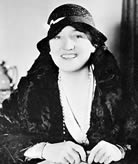Mystery Books
Mystery Movies
Mystery Authors
Mary Roberts Rinehart biography
Mary Roberts Rinehart was born in Allegheny (now the North Side of Pittsburgh), Pennsylvania in 1876. Early in her life her father held a relatively prosperous position as a sewing machine agent while her mother earned extra money for the household as a dressmaker. As a young woman she was an avid reader, borrowing Dumas, Balzac, Zola and others from the Mayor's office library. However, her passion for literature was, and remained to be, always for the stories themselves as opposed to their more critical implications. She entered high school opting for the English program in which she received mediocre grades reflecting the financial problems that plagued her household as her father had lost his sewing machine franchise and embarked on a series of unprofitable inventions of his brother's and his design. Her gift for writing was clear even then with the publication of several short stories in Pittsburgh newspapers while in high school.
At the generosity of her uncle, Mary entered nursing school and began her training at the local hospital. There, she made the acquaintance of a young surgeon, Dr. Stanley Rinehart, and in a short time the two were engaged. Following her graduation they married in the spring of 1896 and moved to a home which also served as a private practice run by the couple. In her free time Rinehart wrote short stories and poems, sending them to various publication for which she was awarded small sums. A stock market crash of 1904, sending the Rineharts into $12,000 of debt, encouraged Mary to take on her writing more seriously in order to assist in the financial crisis.
In 1908, with the publication of The Circular Staircase, first as a serial in All-Story and then as her first novel, her career as a serious and successful writer began. Her income was now substantial, no longer simply a bit of extra money that afforded her household a few modest luxuries. In 1909 two more of her serials were published as books, The Man in the Lower 10 being the first American mystery novel to become a best seller, and the highly successful play Seven Days opened. Her profits allowed the Rineharts to move to and support a more substantial home in the winter of 1911 following a trip to Switzerland where her husband furthered his training as a surgeon.
The move is evidence of Mary's epicurean tastes, a reaction to the genteel poverty of her youth. Often her fictions revolved around the wealthy, for instance the affluent spinster Rachel Innes of The Circular Staircase. Her tastes for homes, couture, jewelry, expensive vacations and other such indulgences followed her through her life and career, increasing proportionately with her ever growing popularity and fortune. Her luxury, however, never comprised her work ethic. In her 1939 essay Writing is Work, published in The Saturday Evening Post, she maintains that her writing represented a strong and often exhausting devotion to the craft requiring methodic routine and strong steadfast discipline.
Throughout her career, and financial prosperity, Mary possessed a marked spirit of adventure. In 1915, at thirty-eight and with three children, she left for Europe to cover World War I for the Post. She toured Belgium and was received by King Albert, taking his first authorized statement regarding the war since its start. She interviewed Winston Churchill and Queen Mary in England, toured hospitals and the French and English lines. Her collected articles were published in the 1915 Kings, Queens and Pawns. Upon her return from the Front, Rinehart left for the American West, passing through Indian reservations and was initiated into the Blackfoot tribe. She found sympathy for the Native American's cause and following the expedition met with the Secretary of the Interior to make a plea for aid. Her travels through the West are described in several pieces of writing, both of fiction and non-fiction. She made a second voyage to the battlefields of Europe in 1918 sponsored by the War Department.
In December of 1940 The New York Times Book Review printed a long interview with Rinehart and next to it lays a piece on the importance of “escape literature,” that which allows readers to forget the troubles of their modern world. This placement is fitting because, if anything can be classified as escapist literature, it is Rinehart's writing. Her immense popularity stemmed from its humor, warmth and often its descriptions of a lifestyle more extravagant than many of her readers. Mary was continually wary of the American Modernists, even at the height of the period, and often openly criticized them. Although her comments were poignant and articulate, they can seem obtuse. It was she, however, who was in touch with the majority of the American public throughout the sorrow brought on by the First World War and the Great Depression as they were transported into a world more exciting and ideal than their own.
Outliving her husband by twenty-five years, she divided her later years between her luxurious eighteen-room Park Avenue apartment and her home in Bar Harbor, Maine, continuing to write prolifically. Following her husband's death, she and her sons formed a publishing form, Rinehart & Co., which she served as a director of and wrote under. By this time it was estimated that her novels sold over 10,000,000 copies in English and thirteen translations. Rinehart passed away peacefully on September 22, 1958, in New York City.
Information source: wikipedia